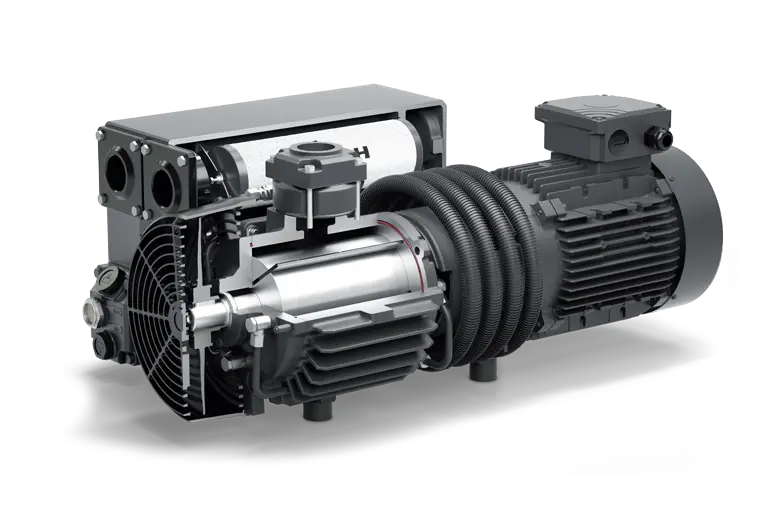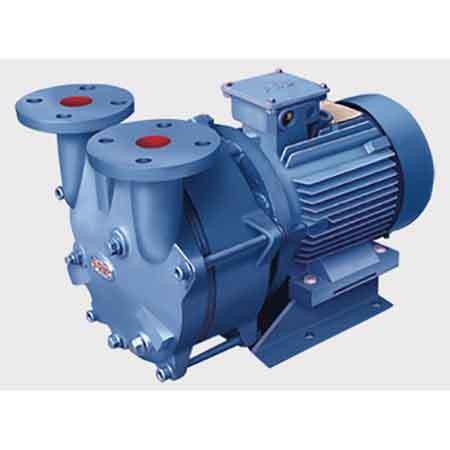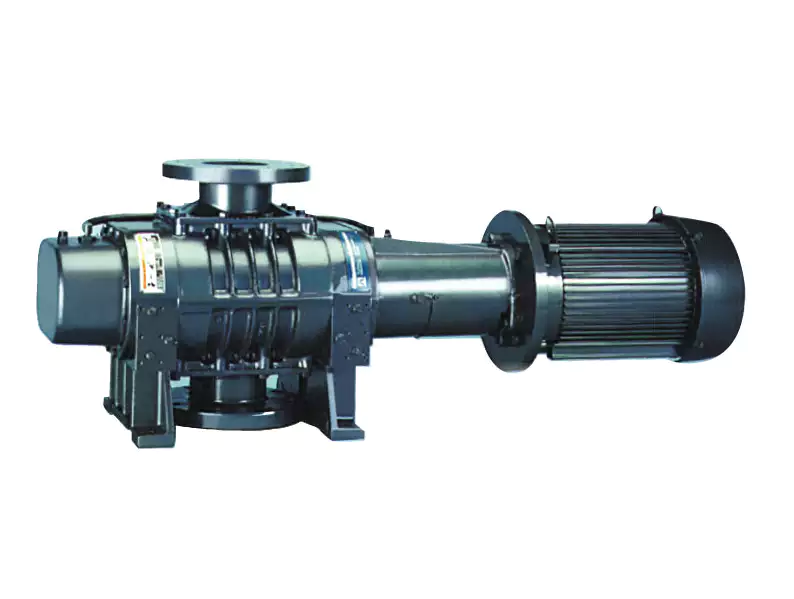Product Description
Product Description
SK series liquid ring vacuum pumps and compressors are used to pump or compress air and other non-corrosive, water-insoluble and CHINAMFG particle-free gases to generate vacuum or pressure in closed containers, and a small amount of liquid is allowed with the inhaled gas. It is widely used in machinery, petrochemical, pharmaceutical, food, sugar industry and paper making. Because the compression process of gas is isothermal, it is unlikely to be dangerous with explosive gases, which makes its application more widely.
2SK series 2 stage liquid ring vacuum pumps whose suction speed is great even in higher vacuum,are more fit to work when the suction pressure is between -0.085MPa~0.095MPa.
Technical data
Technical data of SK series Liquid ring vacuum pump
| Model | Pumping Speed(m3/min) | Ultimate Pressure | Motor Power(kw) | Pump Rotation Speed(rpm) | Compresssor pressure(MPa) | Connection size | Water required(L/min) | ||||
| Max | Inlet pressure:-0.06MPa | (mmHg) | (MPa) | Vacuum pump | Compressor | Inlet | Outlet | ||||
| SK-0.4 | 0.4 | 0.36 | -700 | -0.093 | 1.5 | / | 2840 | / | G1″ | G1″ | |
| SK-0.8 | 0.8 | 0.72 | -700 | -0.093 | 2.2 | / | 2840 | / | G1″ | G1″ | |
| SK-1.5B | 1.5 | 1.35 | -700 | -0.093 | 4 | / | 2860 | / | G1″/4″ | G1″/4″ | |
| SK-1.5 | 1.5 | 1.35 | -700 | -0.093 | 4 | 5.5 | 1440 | 0.15 | 70 | 70 | 20-30 |
| SK-3 | 3 | 2.8 | -700 | -0.093 | 5.5 | 7.5 | 1440 | 0.15 | 70 | 70 | 40-50 |
| SK-6 | 6 | 5.4 | -700 | -0.093 | 11 | 15 | 1440 | 0.15 | 80 | 80 | 50-60 |
| SK-12 | 12 | 10.8 | -700 | -0.093 | 18.5 | 30 | 970 | 0.15 | 80 | 80 | 60-70 |
| SK-20 | 20 | 18 | -700 | -0.093 | 37 | 55 | 730 | 0.15 | 150 | 150 | 70-80 |
| SK-30 | 30 | 27 | -700 | -0.093 | 55 | 75 | 730 | 0.15 | 150 | 150 | 90-100 |
| SK-42 | 42 | 37.8 | -700 | -0.093 | 75 | / | 730 | / | 150 | 150 | 120-140 |
| SK-60 | 60 | 54 | -700 | -0.093 | 95 | / | 550 | / | 250 | 250 | 140-160 |
| SK-85 | 85 | 76.5 | -700 | -0.093 | 132 | / | 550 | / | 250 | 250 | 160-180 |
| SK-120 | 120 | 108 | -700 | -0.093 | 185 | / | 490 | / | 300 | 300 | 200-220 |
Technical data of 2SK series Liquid ring vacuum pump
| Model | Pumping Speed(m3/min) | Ultimate Pressure(MPa) | Motor Power(KW) | Motor Speed(r/min) | Water required(L/min) | Inlet size(mm) | Outlet size(mm) | Weight(kg) |
| 2SK-0.4 | 0.4 | -0.097 | 2.2 | 2840 | 5~8 | G1” | G1” | 120 |
| 2SK-0.8 | 0.8 | -0.097 | 3 | 2880 | 10~15 | G1” | G1” | 150 |
| 2SK-1.5 | 1.5 | -0.097 | 4 | 1440 | 20~25 | 40 | 40 | 230 |
| 2SK-3 | 3 | -0.097 | 7.5 | 1440 | 30~40 | 40 | 40 | 320 |
| 2SK-6 | 6 | -0.097 | 15 | 1460 | 45~50 | 50 | 50 | 500 |
| 2SK-9 | 9 | -0.097 | 18.5 | 970 | 50~60 | 100 | 100 | 700 |
| 2SK-12 | 12 | -0.097 | 22 | 970 | 60~70 | 100 | 100 | 800 |
| 2SK-15 | 15 | -0.097 | 30 | 970 | 80~90 | 100 | 100 | 1000 |
| 2SK-20 | 20 | -0.097 | 37 | 740 | 100~120 | 125 | 125 | 1650 |
| 2SK-25 | 25 | -0.097 | 45 | 740 | 120~140 | 125 | 125 | 1800 |
| 2SK-30 | 30 | -0.097 | 55 | 740 | 130~160 | 125 | 125 | 1950 |
FAQ
Q: What information should I offer for an inquiry?
A: You can inquire based on the model directly, but it is always recommended that you contact us so that we can help you to check if the pump is the most appropriate for your application.
Q: Can you make a customized vacuum pump?
A: Yes, we can do some special designs to meet customer applications. Such as customized sealing systems, speical surface treatment can be applied for roots vacuum pump and screw vacuum pump. Please contact us if you have special requirements.
Q: I have problems with our vacuum pumps or vacuum systems, can you offer some help?
A: We have application and design engineers with more than 30 years of experience in vacuum applications in different industries and help a lot of customers resolve their problems, such as leakage issues, energy-saving solutions, more environment-friendly vacuum systems, etc. Please contact us and we’ll be very happy if we can offer any help to your vacuum system.
Q: Can you design and make customized vacuum systems?
A: Yes, we are good for this.
Q: What is your MOQ?
A: 1 piece or 1 set.
Q: How about your delivery time?
A: 5-10 working days for the standard vacuum pump if the quantity is below 20 pieces, 20-30 working days for the conventional vacuum system with less than 5 sets. For more quantity or special requirements, please contact us to check the lead time.
Q: What are your payment terms?
A: By T/T, 50% advance payment/deposit and 50% paid before shipment.
Q: How about the warranty?
A: We offer 1-year warranty (except for the wearing parts).
Q: How about the service?
A: We offer remote video technical support. We can send the service engineer to the site for some special requirements.
/* January 22, 2571 19:08:37 */!function(){function s(e,r){var a,o={};try{e&&e.split(“,”).forEach(function(e,t){e&&(a=e.match(/(.*?):(.*)$/))&&1
| After-sales Service: | Online Video Instruction |
|---|---|
| Warranty: | 1 Year |
| Max Pumping Speed: | 120m3/Min |
| Pumping Speed (Inlet Pressure: -0.06MPa): | 108m3/Min |
| Ultimate Pressure: | -700 Mmhg |
| Motor Voltage: | 380V |

Can Vacuum Pumps Be Used in the Aerospace Sector?
Vacuum pumps indeed have various applications in the aerospace sector. Here’s a detailed explanation:
Vacuum pumps play a crucial role in several areas of the aerospace industry, supporting various processes and systems. Some of the key applications of vacuum pumps in the aerospace sector include:
1. Space Simulation Chambers: Vacuum pumps are used in space simulation chambers to replicate the low-pressure conditions experienced in outer space. These chambers are utilized for testing and validating the performance and functionality of aerospace components and systems under simulated space conditions. Vacuum pumps create and maintain the necessary vacuum environment within these chambers, allowing engineers and scientists to evaluate the behavior and response of aerospace equipment in space-like conditions.
2. Propellant Management: In space propulsion systems, vacuum pumps are employed for propellant management. They help in the transfer, circulation, and pressurization of propellants, such as liquid rocket fuels or cryogenic fluids, in both launch vehicles and spacecraft. Vacuum pumps assist in creating the required pressure differentials for propellant flow and control, ensuring efficient and reliable operation of propulsion systems.
3. Environmental Control Systems: Vacuum pumps are utilized in the environmental control systems of aircraft and spacecraft. These systems are responsible for maintaining the desired atmospheric conditions, including temperature, humidity, and cabin pressure, to ensure the comfort, safety, and well-being of crew members and passengers. Vacuum pumps are used to regulate and control the cabin pressure, facilitating the circulation of fresh air and maintaining the desired air quality within the aircraft or spacecraft.
4. Satellite Technology: Vacuum pumps find numerous applications in satellite technology. They are used in the fabrication and testing of satellite components, such as sensors, detectors, and electronic devices. Vacuum pumps help create the necessary vacuum conditions for thin film deposition, surface treatment, and testing processes, ensuring the performance and reliability of satellite equipment. Additionally, vacuum pumps are employed in satellite propulsion systems to manage propellants and provide thrust for orbital maneuvers.
5. Avionics and Instrumentation: Vacuum pumps are involved in the production and testing of avionics and instrumentation systems used in aerospace applications. They facilitate processes such as thin film deposition, vacuum encapsulation, and vacuum drying, ensuring the integrity and functionality of electronic components and circuitry. Vacuum pumps are also utilized in vacuum leak testing, where they help create a vacuum environment to detect and locate any leaks in aerospace systems and components.
6. High Altitude Testing: Vacuum pumps are used in high altitude testing facilities to simulate the low-pressure conditions encountered at high altitudes. These testing facilities are employed for evaluating the performance and functionality of aerospace equipment, such as engines, materials, and structures, under simulated high altitude conditions. Vacuum pumps create and control the required low-pressure environment, allowing engineers and researchers to assess the behavior and response of aerospace systems in high altitude scenarios.
7. Rocket Engine Testing: Vacuum pumps are crucial in rocket engine testing facilities. They are utilized to evacuate and maintain the vacuum conditions in engine test chambers or nozzles during rocket engine testing. By creating a vacuum environment, these pumps simulate the conditions experienced by rocket engines in the vacuum of space, enabling accurate testing and evaluation of engine performance, thrust levels, and efficiency.
It’s important to note that aerospace applications often require specialized vacuum pumps capable of meeting stringent requirements, such as high reliability, low outgassing, compatibility with propellants or cryogenic fluids, and resistance to extreme temperatures and pressures.
In summary, vacuum pumps are extensively used in the aerospace sector for a wide range of applications, including space simulation chambers, propellant management, environmental control systems, satellite technology, avionics and instrumentation, high altitude testing, and rocket engine testing. They contribute to the development, testing, and operation of aerospace equipment, ensuring optimal performance, reliability, and safety.

Can Vacuum Pumps Be Used for Chemical Distillation?
Yes, vacuum pumps are commonly used in chemical distillation processes. Here’s a detailed explanation:
Chemical distillation is a technique used to separate or purify components of a mixture based on their different boiling points. The process involves heating the mixture to evaporate the desired component and then condensing the vapor to collect the purified substance. Vacuum pumps play a crucial role in chemical distillation by creating a reduced pressure environment, which lowers the boiling points of the components and enables distillation at lower temperatures.
Here are some key aspects of using vacuum pumps in chemical distillation:
1. Reduced Pressure: By creating a vacuum or low-pressure environment in the distillation apparatus, vacuum pumps lower the pressure inside the system. This reduction in pressure lowers the boiling points of the components, allowing distillation to occur at temperatures lower than their normal boiling points. This is particularly useful for heat-sensitive or high-boiling-point compounds that would decompose or become thermally degraded at higher temperatures.
2. Increased Boiling Point Separation: Vacuum distillation increases the separation between the boiling points of the components, making it easier to achieve a higher degree of purification. In regular atmospheric distillation, the boiling points of some components may overlap, leading to less effective separation. By operating under vacuum, the boiling points of the components are further apart, improving the selectivity and efficiency of the distillation process.
3. Energy Efficiency: Vacuum distillation can be more energy-efficient compared to distillation under atmospheric conditions. The reduced pressure lowers the required temperature for distillation, resulting in reduced energy consumption and lower operating costs. This is particularly advantageous when dealing with large-scale distillation processes or when distilling heat-sensitive compounds that require careful temperature control.
4. Types of Vacuum Pumps: Different types of vacuum pumps can be used in chemical distillation depending on the specific requirements of the process. Some commonly used vacuum pump types include:
– Rotary Vane Pumps: Rotary vane pumps are widely used in chemical distillation due to their ability to achieve moderate vacuum levels and handle various gases. They work by using rotating vanes to create chambers that expand and contract, enabling the pumping of gas or vapor.
– Diaphragm Pumps: Diaphragm pumps are suitable for smaller-scale distillation processes. They use a flexible diaphragm that moves up and down to create a vacuum and compress the gas or vapor. Diaphragm pumps are often oil-free, making them suitable for applications where avoiding oil contamination is essential.
– Liquid Ring Pumps: Liquid ring pumps can handle more demanding distillation processes and corrosive gases. They rely on a rotating liquid ring to create a seal and compress the gas or vapor. Liquid ring pumps are commonly used in chemical and petrochemical industries.
– Dry Screw Pumps: Dry screw pumps are suitable for high-vacuum distillation processes. They use intermeshing screws to compress and transport gas or vapor. Dry screw pumps are known for their high pumping speeds, low noise levels, and oil-free operation.
Overall, vacuum pumps are integral to chemical distillation processes as they create the necessary reduced pressure environment that enables distillation at lower temperatures. By using vacuum pumps, it is possible to achieve better separation, improve energy efficiency, and handle heat-sensitive compounds effectively. The choice of vacuum pump depends on factors such as the required vacuum level, the scale of the distillation process, and the nature of the compounds being distilled.

Can Vacuum Pumps Be Used in the Medical Field?
Yes, vacuum pumps have a wide range of applications in the medical field. Here’s a detailed explanation:
Vacuum pumps play a crucial role in various medical applications, providing suction or creating controlled vacuum environments. Here are some key areas where vacuum pumps are used in the medical field:
1. Negative Pressure Wound Therapy (NPWT):
Vacuum pumps are extensively utilized in negative pressure wound therapy, a technique used to promote wound healing. In NPWT, a vacuum pump creates a controlled low-pressure environment within a wound dressing, facilitating the removal of excess fluid, promoting blood flow, and accelerating the healing process.
2. Surgical Suction:
Vacuum pumps are an integral part of surgical suction systems. They provide the necessary suction force to remove fluids, gases, or debris from the surgical site during procedures. Surgical suction helps maintain a clear field of view for surgeons, enhances tissue visualization, and contributes to a sterile operating environment.
3. Anesthesia:
In anesthesia machines, vacuum pumps are used to create suction for various purposes:
– Airway Suction: Vacuum pumps assist in airway suctioning to clear secretions or obstructions from the patient’s airway during anesthesia or emergency situations.
– Evacuation of Gases: Vacuum pumps aid in removing exhaled gases from the patient’s breathing circuit, ensuring the delivery of fresh gas mixtures and maintaining appropriate anesthesia levels.
4. Laboratory Equipment:
Vacuum pumps are essential components in various medical laboratory equipment:
– Vacuum Ovens: Vacuum pumps are used in vacuum drying ovens, which are utilized for controlled drying or heat treatment of sensitive materials, samples, or laboratory glassware.
– Centrifugal Concentrators: Vacuum pumps are employed in centrifugal concentrators to facilitate the concentration or dehydration of biological samples, such as DNA, proteins, or viruses.
– Freeze Dryers: Vacuum pumps play a vital role in freeze-drying processes, where samples are frozen and then subjected to vacuum conditions to remove water via sublimation, preserving the sample’s structure and integrity.
5. Medical Suction Devices:
Vacuum pumps are utilized in standalone medical suction devices, commonly found in hospitals, clinics, and emergency settings. These devices create suction required for various medical procedures, including:
– Suctioning of Respiratory Secretions: Vacuum pumps assist in removing respiratory secretions or excess fluids from the airways of patients who have difficulty coughing or clearing their airways effectively.
– Thoracic Drainage: Vacuum pumps are used in chest drainage systems to evacuate air or fluid from the pleural cavity, helping in the treatment of conditions such as pneumothorax or pleural effusion.
– Obstetrics and Gynecology: Vacuum pumps are employed in devices used for vacuum-assisted deliveries, such as vacuum extractors, to aid in the safe delivery of babies during childbirth.
6. Blood Collection and Processing:
Vacuum pumps are utilized in blood collection systems and blood processing equipment:
– Blood Collection Tubes: Vacuum pumps are responsible for creating the vacuum inside blood collection tubes, facilitating the collection of blood samples for diagnostic testing.
– Blood Separation and Centrifugation: In blood processing equipment, vacuum pumps assist in the separation of blood components, such as red blood cells, plasma, and platelets, for various medical procedures and treatments.
7. Medical Imaging:
Vacuum pumps are used in certain medical imaging techniques:
– Electron Microscopy: Electron microscopes, including scanning electron microscopes and transmission electron microscopes, require a vacuum environment for high-resolution imaging. Vacuum pumps are employed to maintain the necessary vacuum conditions within the microscope chambers.
These are just a few examples of the wide-ranging applications of vacuum pumps in the medical field. Their ability to create suction and controlled vacuum environments makes them indispensable in medical procedures, wound healing, laboratory processes, anesthesia, and various other medical applications.


editor by Dream 2024-04-29
by
Leave a Reply